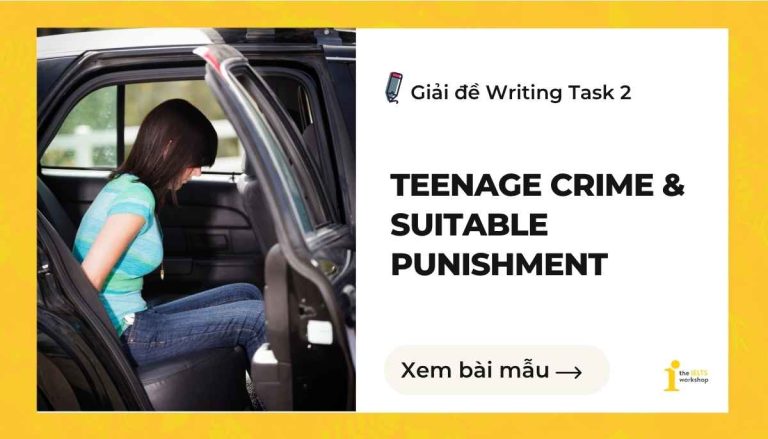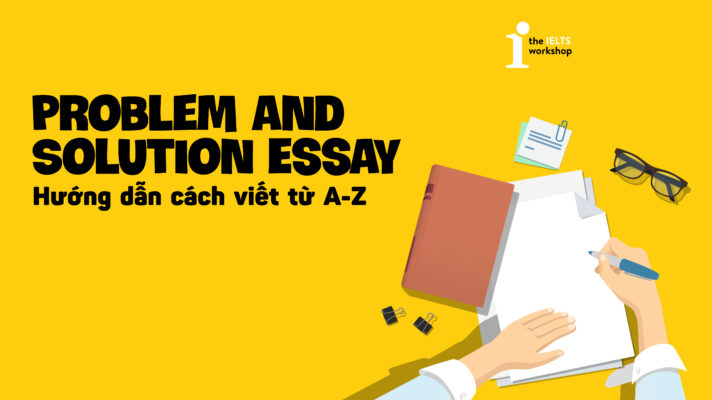Teenage crime & suitable punishment là chủ đề quen thuộc trong IELTS Writing Task 2, thường yêu cầu người viết đánh giá mức độ trừng phạt phù hợp với người trẻ phạm tội nghiêm trọng. Trong bài viết này, thầy Phạm Duy Anh từ The IELTS Workshop sẽ gợi ý cách tiếp cận rõ ràng, giúp bạn lập luận thuyết phục và cân bằng với chủ đề này.
1. Phân tích
1.1. Đề bài Teenage crime & suitable punishment trong IELTS Writing Task 2
Some people believe that young people who commit serious crimes should be punished in the same way as adults. To what extent do you agree or disagree?
(Nhiều người tin rằng, những người trẻ đã phạm tội nghiêm trọng nên bị xét xử giống như những người trưởng thành. Bạn có đồng ý với ý kiến này không?)
1.2. Phân tích đề bài
- Dạng bài: Opinion essay
- Chủ đề: whether youngsters who commit crimes should receive similar punishment to adults
- Keywords: young people; crimes; punish; adults; agree / disagree
Xem thêm: Học cách làm dạng Balanced Opinion Essay trong IELTS Writing
1.3. Dàn bài chi tiết
Introduction
- Paraphrase đề bài:
- → Có ý kiến cho rằng người trẻ phạm tội nghiêm trọng nên bị xử phạt giống người trưởng thành.
- Câu dẫn vào bài:
- → Theo tôi, mặc dù một số trường hợp cần có hình phạt tương đương, nhưng hệ thống pháp luật nên cân nhắc đến độ tuổi và hoàn cảnh tâm lý của người phạm tội.
- Cấu trúc gợi ý:
- → Some believe that serious juvenile offenders deserve adult-level punishment. While this may be appropriate in extreme cases, I believe age and mental maturity must also be taken into account.
Body Paragraph 1: Đồng ý – Trường hợp tội phạm nghiêm trọng có chủ đích
Lập luận chính:
→ Một số thanh thiếu niên gây ra tội ác có tổ chức, lên kế hoạch kỹ lưỡng như người lớn, cần chịu trách nhiệm tương xứng.
Ví dụ:
→ Giết người, khủng bố, hiếp dâm có chủ đích.
Giải thích:
→ Công lý cần được đảm bảo cho nạn nhân, và hình phạt nghiêm khắc có tác dụng răn đe.
Cấu trúc gợi ý:
→ In certain severe cases, such as premeditated murder or terrorism, young offenders should face the same consequences as adults, as justice must be served and deterrence maintained.
Body Paragraph 2: Không đồng ý – Xem xét yếu tố phát triển tâm lý
Lập luận chính:
→ Trẻ vị thành niên chưa hoàn thiện về mặt cảm xúc và nhận thức, dễ bị ảnh hưởng bởi hoàn cảnh.
Ví dụ:
→ Bị bạn bè dụ dỗ, sống trong môi trường bạo lực, thiếu giáo dục.
Giải thích:
→ Với những trường hợp này, cải tạo và giáo dục nên được ưu tiên hơn là trừng phạt nặng nề.
Cấu trúc gợi ý:
→ However, many juveniles lack the emotional and cognitive maturity of adults, and their actions are often driven by peer pressure or difficult environments. Rehabilitation should be prioritized.
Body Paragraph 3: Phản biện – Một hình phạt áp dụng chung sẽ gây bất công
Ý kiến đối lập:
→ Có người cho rằng trừng phạt nghiêm khắc là cách duy nhất để ngăn chặn tội phạm vị thành niên.
Phản biện:
→ Tuy nhiên, hình phạt đồng nhất sẽ bỏ qua sự khác biệt về hoàn cảnh và nguy cơ dẫn đến oan sai.
Ví dụ:
→ Một thiếu niên bị rối loạn tâm thần không được điều trị.
Cấu trúc gợi ý:
→ While equal punishment may seem fair, a one-size-fits-all approach ignores the diversity of individual circumstances and can lead to injustice.
Conclusion
Tóm tắt nguyên nhân:
→ Một số tội ác nghiêm trọng cần xử lý nghiêm. Tuy nhiên, nhiều người trẻ chưa đủ trưởng thành để bị phạt như người lớn.
Tóm tắt giải pháp / kết luận:
→ Hệ thống pháp luật nên kết hợp giữa công lý và cải tạo, dựa vào cả mức độ tội ác và độ tuổi người phạm tội.
Cấu trúc gợi ý:
→ In conclusion, while serious juvenile offenders must be held accountable, equal punishment should not be automatic. A balanced approach that considers both justice and rehabilitation is essential.
2. Bài mẫu (Sample)
It is thought that juveniles who commit serious crimes should receive similar punishments to adult criminals. From my perspective, while criminals of any age should be punished, younger individuals should receive a less severe form of sentence compared to adults.
To begin with, it can be argued that individuals younger than 18 years old make rash decisions that border on criminal activities as a response to certain actions made against them. Specific societal factors such as bullying, harassment, or negative influences during children’s upbringing may contribute to the tendency to commit crimes as a hasty response. For instance, numerous juvenile criminals are reported to have been victims of bullying, assault, or sexual abuse, to which they responded with violence as a form of self-defense. This raises debates on whether schools and relevant authorities have cared enough about youngsters’ well-being.
In addition, youngsters who commit crimes are often those who may not have a sound mind. Mental issues are often documented as a common factor found in those who commit crime, influence their line of thinking, and ease them into believing radicalized ideas and extreme ways of thinking. Numerous examples of public school shootings committed by young individuals were mostly attributed to them believing in hateful beliefs passed down via generations or found on media, and having a history of mental conditions such as bipolar disorder, borderline personality disorder, and schizophrenia.
On the other hand, it should be noted that while self-defense and mental disorders can serve as justifications to why punishments should be less severe, for those who wantonly murder or commit intentional public manslaughter, it would be beneficial for the majority of people that the perpetrators, regardless of age, should be given the most severe forms of punishment. Specific exceptions can be found in mass murderers or serial killers who were underage, yet boasted a high body count as a twisted form of achievement. Therefore, for individuals who were deliberate in their actions should receive similar punishments to adults.
In conclusion, while appropriate sentences should be given, one should gauge the circumstances that lead to youngsters committing crimes, then gauge more lenient degrees of the sentences. It is with hope that via rehabilitation and proper therapy, juvenile individuals can be able to restart their life and become productive members of society.
Sample by Pham Duy Anh – IELTS Teacher at The IELTS Workshop
3. Từ vựng (Vocabulary)
- Juvenile (n/adj): vị thành niên
- Severe (adj): nghiêm trọng, khắt khe
- Rash (adj): hấp tấp, thiếu suy nghĩ
- Upbringing (n): quá trình trưởng thành, sự nuôi dưỡng
- Self-defense (n): sự tự vệ
- Radicalized (adj): bị cực đoan hoá
- Extreme (adj): cực đoan
- Wanton (adj): cố tình, tàn nhẫn
- Deliberate (adj): có chủ đích, cố ý
- Twisted (adj): lệch lạc, bệnh hoạn
- Gauge (v): đánh giá, xem xét
- Rehabilitation (n): sự cải tạo, phục hồi nhân cách
Xem thêm: Tổng hợp 30+ Cách diễn đạt & Từ vựng Chủ đề Crime trong IELTS
Tạm kết
Hy vọng bài viết của thầy Phạm Duy Anh đã giúp bạn hiểu cách xử lý chủ đề Teenage crime & suitable punishment một cách logic và hiệu quả. Nếu bạn muốn luyện tập thêm các dạng bài tương tự, đừng quên theo dõi chuyên mục [Cập nhật liên tục] Tổng hợp đề thi IELTS Writing 2025 kèm bài mẫu và Bài mẫu Writing Task 2 từ The IELTS Workshop nhé!
Học IELTS 0 ĐỒNG ngay tại HỌC IELTS MIỄN PHÍ cùng các thầy cô tại The IELTS Workshop nhé !









